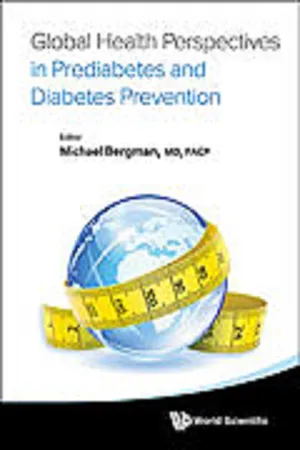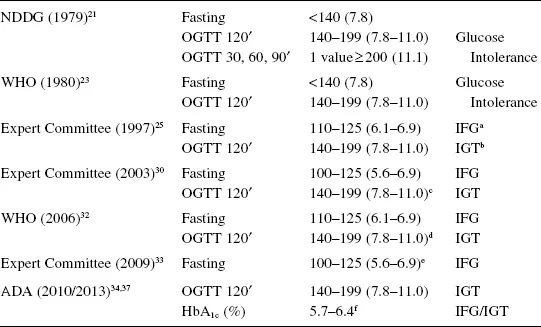
- 500 pages
- English
- ePUB (mobile friendly)
- Available on iOS & Android
Global Health Perspectives In Prediabetes And Diabetes Prevention
About This Book
This comprehensive text is unique in its compilation of experiences in addressing the global diabetes epidemic and description of diverse worldwide prevention initiatives. Background chapters describe the diagnosis and definition of diabetes, the epidemiology, pathophysiology of prediabetes as well as clinical trial evidence for diabetes prevention and treatment. Furthermore, the critical role of government in formulating a global health agenda, policy perspectives for European initiatives, the importance of nutritional policies for diabetes prevention as well as the development of the necessary capacity and infrastructure for diabetes prevention are described. Given the prevalence of diabetes in South Asians and migrants, one chapter focuses on risk factors and prevention of diabetes in these communities. Other chapters detail local and regional approaches covering a truly global span: United States, Latin America, Europe, India, Turkey, (Siberia) Russia, the Middle East and North Africa, South Africa, Israel, East Asia and Australia.
Authored by academic experts in endocrinology and diabetes and global leaders in epidemiology and public health, this landmark text is an authoritative reference for a diverse audience including government, public health and policy experts and researchers, academicians, healthcare professionals, endocrinologists and clinicians interested in prediabetes and diabetes prevention, graduate students and faculty in public and global health graduate programs, epidemiologists, nutritionists, sociologists and those in translational medicine. Readers will broaden their awareness of the prevailing and burgeoning diabetes epidemic and the remarkably creative worldwide prevention initiatives undertaken to address the seemingly insurmountable inherent challenges posed by this global health care crisis. The text is an attestation to the wonderful potential for enormous human collaboration and achievement when communal organizations, governments at local, regional and national levels, researchers, the medical and public health communities, and nutrition experts join with global citizenry in confronting one of the most significant healthcare challenges witnessed in this century.
Readership: Academicians, clinicians, endocrinologists, epidemiologists, healthcare professionals, government, public health and policy experts and researchers, graduate students and faculty in public and global health graduate programs, nutritionists, sociologists, translational medicine, preventive medicine and others (agriculture and food industry, community planning).
Frequently asked questions
Information
Chapter 1: Diagnosis and Definition

1. THE PAST HISTORY OF “GLUCOSE INTOLERANCE”
2. THE MODERN ERA OF “PREDIABETES”
2.1. Step 1

Table of contents
- Cover Page
- Title Page
- Copyright Page
- Contents
- Preface
- Chapter 1: Diagnosis and Definition
- Chapter 2: Epidemiology of Prediabetes
- Chapter 3: Pathophysiology of Prediabetes: Role of Lipotoxicity?
- Chapter 4: Primary Prevention Trials in Type 2 Diabetes
- Chapter 5: Treatment of Prediabetes
- Chapter 6: Diabetes Prevention and Nutrition Policies from a Global Perspective
- Chapter 7: Global Health and Governmental Policies in Diabetes Prevention
- Chapter 8: Infrastructure and Capacity for Diabetes Prevention in The United States
- Chapter 9: Epidemiological Trends, Risk Factors and Prevention of Diabetes: Special Focus on South Asians and Migrants
- Chapter 10: European Initiatives in Diabetes Prevention: Policy Perspectives
- Chapter 11: Real Life Diabetes Prevention in Europe
- Chapter 12: Characteristics of Prediabetes/Diabetes and Prevention Initiatives in East Asia
- Chapter 13: Real Life Diabetes Prevention Initiatives in India
- Chapter 14: Diabetes Prevention in the Middle East and North Africa Region
- Chapter 15: Prediabetes and Diabetes Prevention in South Africa
- Chapter 16: Prevention of Diabetes in Israel
- Chapter 17: Diabetes Prevention in Australia: The Challenges of Scaling-up and Rolling-out Programs
- Chapter 18: Prediabetes and Diabetes Prevention Initiatives in Turkey
- Chapter 19: Prediabetes and Diabetes Prevention Initiatives in Siberia, Russia
- Chapter 20: Prediabetes and Diabetes Prevention Initiatives in Latin-America (LA)
- Index